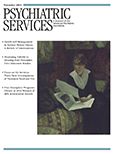Characteristics of Adolescents Subjected to Restraint in Acute Psychiatric Units in Norway: A Case-Control Study
Abstract
Objective:
Use of restraint in psychiatric treatment is controversial. This study compared social, mental health, and treatment characteristics of restrained and nonrestrained adolescents in acute psychiatric inpatient units.
Methods:
In a retrospective case-control design, we included all adolescents restrained during 2008–2010 (N=288) in all acute psychiatric inpatient units that accepted involuntarily admitted adolescents in Norway (N=16). A control group (N=288) of nonrestrained adolescent patients was randomly selected from the same units. Restraint included mechanical restraint, pharmacological restraint, seclusion, and physical holding. Data sources were electronic patient records and restraint protocols. Binary logistic regression analyses were performed to predict restraint use.
Results:
Compared with nonrestrained adolescents, restrained adolescents were more likely to be immigrants, to live in institutions or foster care, and to have had involvement with child protection services. The restrained adolescents were more likely to have psychotic, eating, or externalizing disorders and lower scores on the Children’s Global Assessment Scale (CGAS). They had multiple admissions and longer stays and were more often involuntarily referred. When the analysis adjusted for age, gender, living arrangements, child protection services involvement, and ICD-10 diagnoses, several variables were significantly associated with restraint: immigrant background, low CGAS score, number of admissions, length of stay, and involuntary referral.
Conclusions:
Restrained and nonrestrained patients differed significantly in social, mental health, and treatment characteristics. These findings may be useful in developing strategies for reducing the use of restraint in child and adolescent psychiatry.



